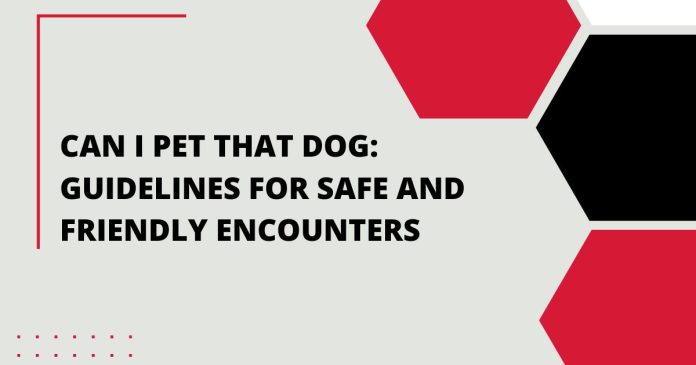In a world filled with furry companions, the sight of a cute, wagging tail often tempts us to reach out and pet the nearest dog. But, before you extend your hand, there are essential considerations to ensure both your safety and the dog’s comfort. In this article, we’ll explore the question, “Can I pet that dog?” and provide you with comprehensive guidelines for safe and friendly encounters with our four-legged friends.
Table of Contents
- Introduction
- Understanding Dog Behavior
- Reading Canine Body Language
- Factors Affecting a Dog’s Temperament
- When to Ask for Permission
- How to Approach a Dog
- The Do’s and Don’ts of Petting
- Dealing with Fearful Dogs
- Encounters with Service Dogs
- Children and Dog Interaction
- Dog Parks Etiquette
- Safety Measures for Dog Owners
- Conclusion
- FAQs
- FAQ 1: What should I do if a dog approaches me?
- FAQ 2: Can I pet a dog without the owner’s consent?
- FAQ 3: Is it safe to approach a dog while it’s eating?
- FAQ 4: How do I know if a dog is friendly?
- FAQ 5: What should I do if a dog growls at me?
Introduction
Dogs have rightfully earned their title as “man’s best friend.” Their loyalty and affection are heartwarming. However, it’s important to remember that not all dogs are comfortable with strangers, and some may react unpredictably if approached without caution. Let’s dive into the world of canine behavior and etiquette to ensure harmonious interactions with our furry companions.
Understanding Dog Behavior
Before reaching out to pet a dog, it’s crucial to understand their behavior. Dogs communicate primarily through body language. Tail position, ear stance, and vocalizations all convey their emotions. Learning to interpret these signs is the first step in safe interaction.
Reading Canine Body Language
- Tail Wagging: Contrary to popular belief, a wagging tail doesn’t always mean a friendly dog. The speed and height of the wag, along with other body cues, provide insights into their mood.
- Ears: Forward-pointing ears often indicate interest, while flattened ears can signal fear or aggression.
- Eye Contact: A soft gaze suggests a relaxed dog, while prolonged staring may be a sign of dominance or discomfort.
- Vocalizations: Barking and growling can signify a range of emotions, from excitement to fear.
Factors Affecting a Dog’s Temperament
A dog’s temperament depends on various factors, including breed, upbringing, and past experiences. Breeds with high energy levels, like Border Collies, may be more excitable, while others, like Basset Hounds, are generally laid-back.
When to Ask for Permission
Always ask the owner for permission before approaching a dog. They know their pet’s temperament better than anyone and can guide you on the best way to interact.
How to Approach a Dog
When approaching a dog, follow these steps:
- Approach slowly and calmly: Sudden movements or loud noises can startle a dog.
- Allow the dog to approach you: Extend your hand for them to sniff; this is how dogs gather information.
- Avoid direct eye contact: It can be perceived as a threat.
The Do’s and Don’ts of Petting
When petting a dog:
Do’s
- Stroke their back or chest gently.
- Use a calm, soothing voice.
- Pay attention to their body language.
Don’ts
- Avoid patting their head, as some dogs find it uncomfortable.
- Never grab or pull their tail or ears.
- Refrain from hugging, as it can be seen as a threat.
Dealing with Fearful Dogs
If a dog appears fearful or anxious, respect their space. Do not force interaction, as it can escalate their anxiety and lead to defensive behavior.
Encounters with Service Dogs
Service dogs are working animals. Unless the owner gives permission, refrain from interacting with them. Disturbing a service dog can hinder their owner’s safety.
Children and Dog Interaction
Supervise children closely when they interact with dogs. Teach them to approach gently and avoid sudden movements.
Dog Parks Etiquette
In dog parks, ensure your dog is well-behaved and follow park rules. Respect the space of other dogs and owners.
Safety Measures for Dog Owners
If you’re a dog owner, ensure your pet is socialized and well-behaved in public. Use a leash in areas where it’s required and be considerate of others.
Conclusion
The question, “Can I pet that dog?” is more than a simple inquiry; it’s an invitation to understand and respect the intricate world of canine behavior. By following these guidelines, you can ensure safe and pleasant interactions with dogs, fostering a sense of trust and camaraderie with our furry companions.
FAQs
FAQ 1: What should I do if a dog approaches me?
If a dog approaches you, stand still and avoid sudden movements. Allow them to sniff your hand. If the owner is present, ask for guidance.
FAQ 2: Can I pet a dog without the owner’s consent?
No, it’s essential to ask for the owner’s permission before petting a dog, even if they appear friendly.
FAQ 3: Is it safe to approach a dog while it’s eating?
No, avoid approaching a dog while it’s eating, as this can trigger defensive behavior.
FAQ 4: How do I know if a dog is friendly?
A friendly dog usually has a relaxed body, wags its tail at a moderate speed, and may approach with a soft gaze.
FAQ 5: What should I do if a dog growls at me?
If a dog growls, back away slowly without making eye contact. This is a sign that the dog is uncomfortable, and further interaction may provoke aggression.

